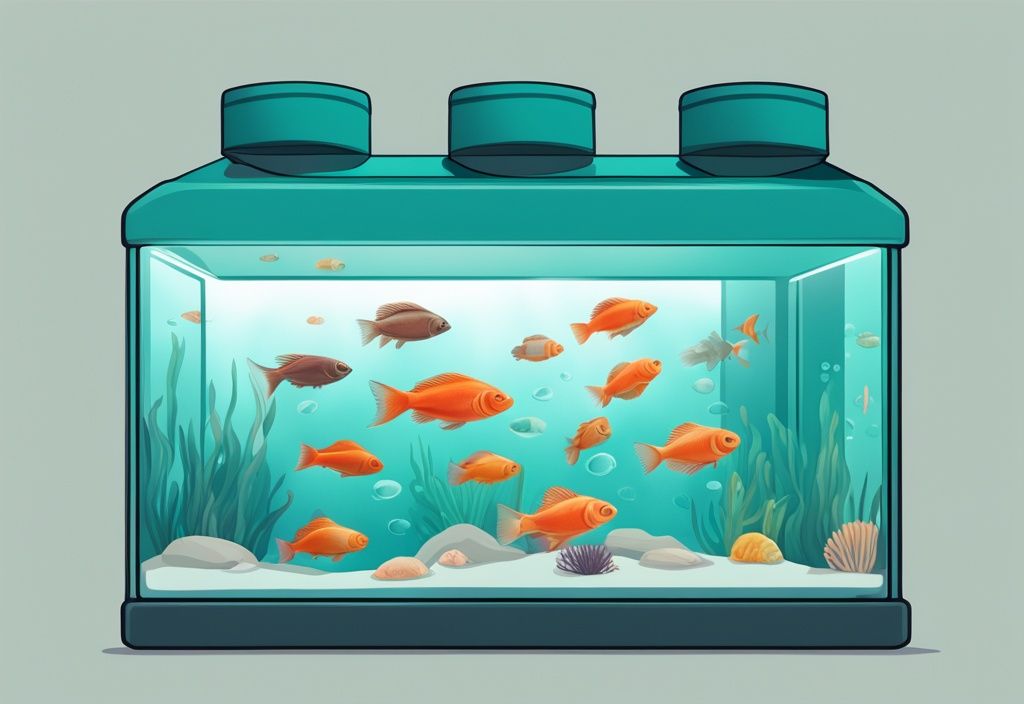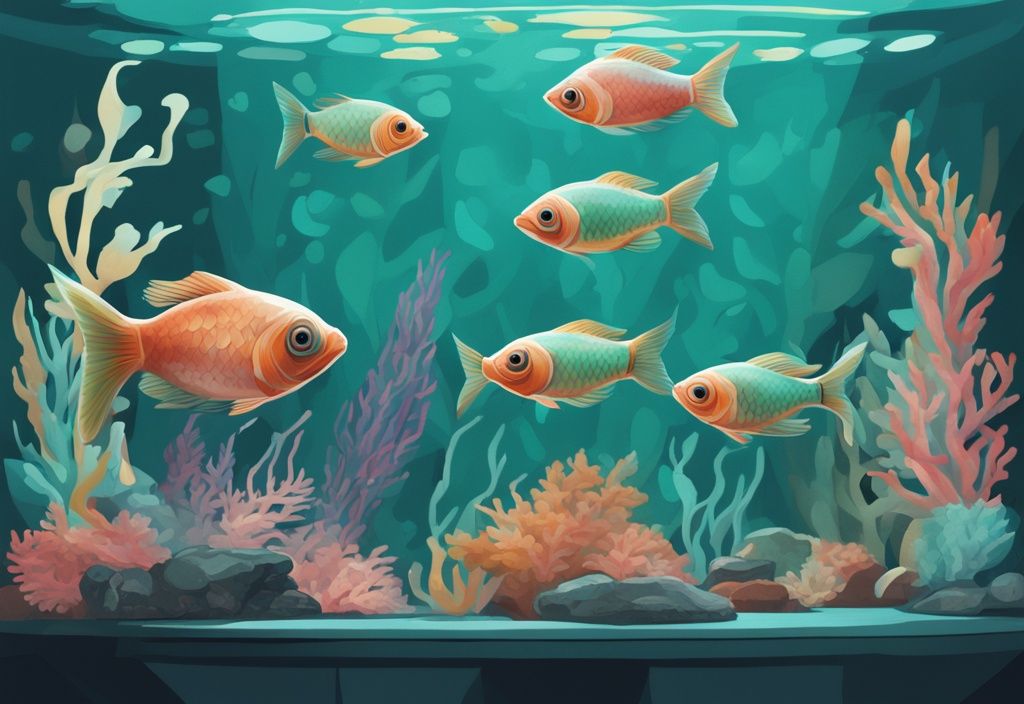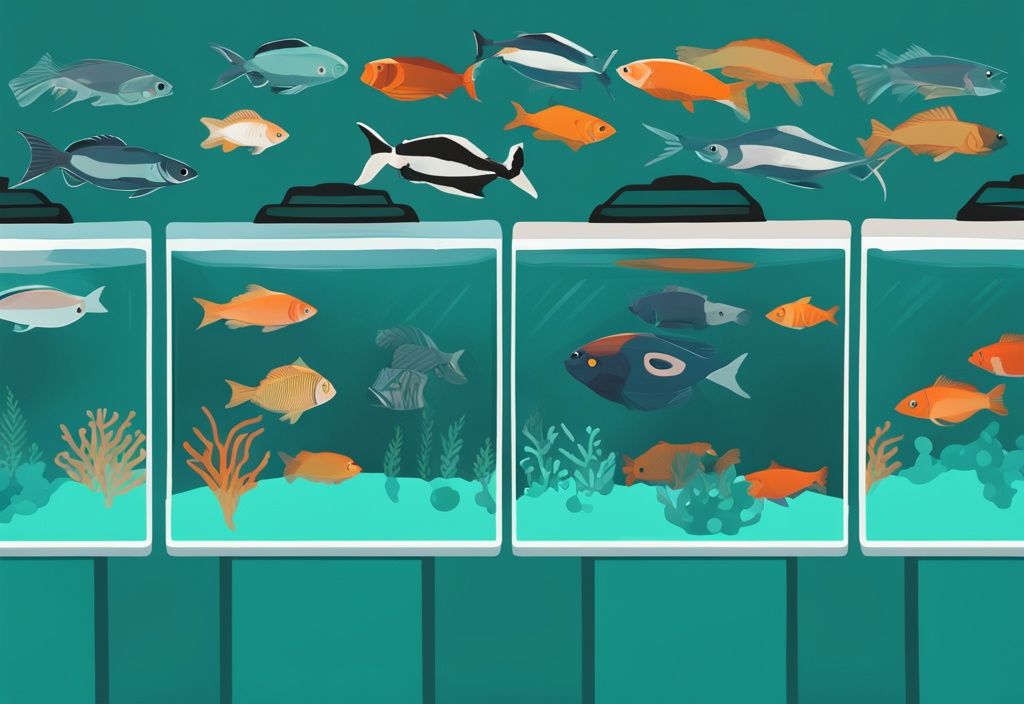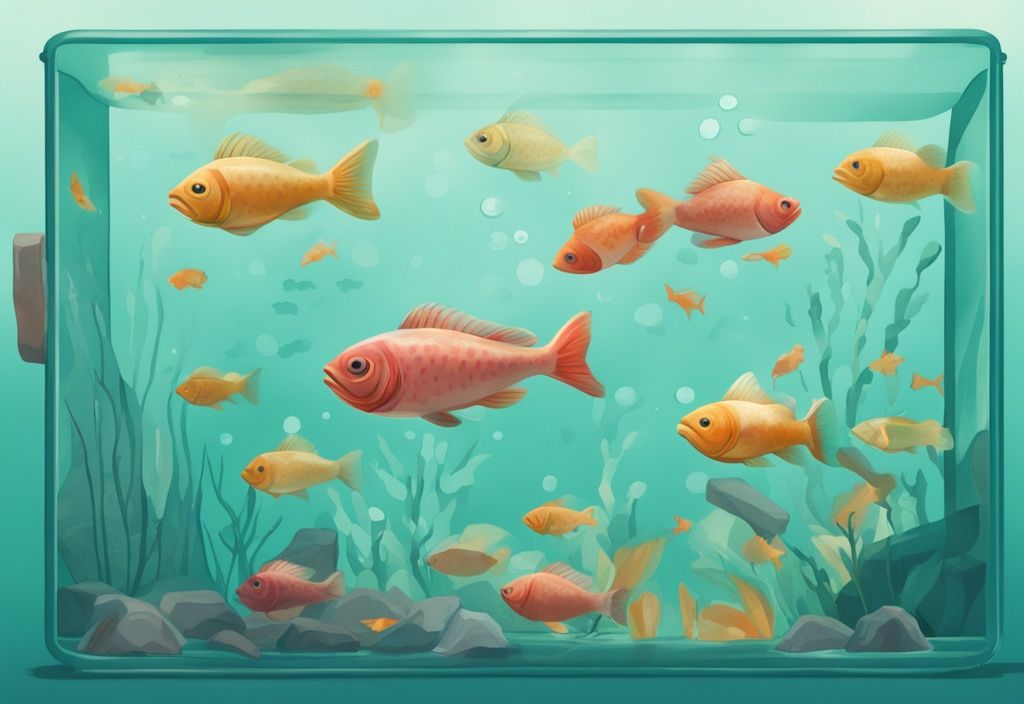Navigating the world of fishkeeping? Ever wondered how many finned companions can cohabit in a 10-gallon tank? With twenty years of marine biology under my belt, I’d say you’ve landed in the right place. Cramming too many fish in your 10-gallon tank can cause considerable problems, such as health issues and water quality degradation – a pitfall all too common for zealous beginners.
This comprehensive guide will unravel how to factor in fish size, behavior and bioload to determine the perfect fish-to-tank ratio. Whether you’re Team Freshwater or Team Saltwater, the insights here are applicable for either side.
So, ready to master the art of fish population management and bring about a harmonious aquatic universe? Let’s go below sea level and truly dive into the joy of successfully maintaining a well-populated 10-gallon wonder.
Key Factors to Determine Fish Quantity in a 10-Gallon Tank
Deciding how many fish can be comfortably housed in a 10-gallon tank involves a careful consideration of several crucial elements. From the size and behavior of the fish to the bioload and growth management, each factor plays a pivotal role in fostering a healthy and thriving aquatic environment.
Fish Size
The size of the fish is a fundamental factor when determining how many fish in a 10-gallon tank. Smaller fish, such as neon tetras or small gobies, usually require less space, making them more suitable candidates for a compact environment.
On the other hand, larger fish, even those that are only a few inches long, can demand more swimming room and may quickly outgrow the limited confines of a 10-gallon tank.
Fish Behavior and Compatibility
Understanding fish behavior and compatibility is essential when deciding how many fish in a 10-gallon tank. Fish activity levels and temperaments vary greatly.
Aggressive species like damsels need more space to mitigate conflicts and might coexist poorly with more peaceful tank mates. Active swimmers also need ample space to move freely compared to stationary or bottom-dwelling species. Ensuring sufficient space for territorial fish helps prevent stress and aggression among tank inhabitants.
Swimming Room and Bioload
Every fish contributes to the tank’s bioload, meaning the waste they produce and the resulting strain on the filtration system. Overcrowding a tank can lead to elevated ammonia and nitrite levels, compromising water quality and fish health.
Additionally, adequate swimming room is critical; a crowded environment can cause stress, making the fish more susceptible to illness. Thus, maintaining a balance between the number of fish and available swimming space is key for a healthy tank ecosystem.
Managing Fish Growth
Fish often begin their lives small but can grow significantly, potentially outgrowing a 10-gallon tank. Understanding the prospective adult size of your fish is vital to maintaining suitable living conditions.
Regular reassessment of the tank’s capacity as the fish mature helps ensure that the environment remains conducive to their health and well-being.
This proactive management is essential to avoid overcrowding and to maintain a stable, healthy ecosystem.
Practical Guidelines to Calculate Fish Population
Understanding the right number of fish for your tank is crucial for maintaining a healthy and balanced aquatic ecosystem. In these guidelines, we delve into methodologies and considerations you should account for when determining the fish population for a 10-gallon tank.
The “1 Inch Per Gallon” Rule Explained
The “1 Inch Per Gallon” rule is a popular guideline among aquarium hobbyists, stating each inch of fish requires one gallon of water. This straightforward concept is particularly appealing to beginners, as it provides a simple metric for planning and approximating fish numbers. While this rule can serve as a useful starting point, relying solely on it can lead to misjudgments regarding the optimal fish population for a 10-gallon tank.

Why the Rule Can Be Misleading
Despite its simplicity, the “1 Inch Per Gallon” rule can be misleading. This guideline fails to consider several crucial factors, including fish behavior, territorial needs, and bioload. For instance, larger fish generate more waste, thus contributing to a higher bioload compared to smaller fish of the same length. This increased waste production necessitates more robust filtration and can strain the tank’s ecology.
Additionally, this rule does not account for the specific needs of various fish species, such as their level of activity or compatibility with tank mates. Active swimmers or aggressive fish require more space and can disrupt the tank’s harmony if not properly managed. Therefore, while the “1 Inch Per Gallon” rule might provide a basic framework, it falls short in specific situations and should be complemented with species-specific research and expert recommendations for a healthy and balanced aquarium environment.
Best Fish Combinations for a 10 Gallon Tank
Suggested Number of Fish
Determining how many fish in a 10 gallon tank requires careful consideration of various factors, including fish size and compatibility. Generally, it’s ideal to house 1-2 medium-small fish or up to 3-4 smaller fish. Overpopulating should be avoided to maintain optimal water quality and minimize stress on the fish.
Balancing fish size and species ensures that space and bioload are adequately managed, promoting a healthy and thriving aquatic environment. Think of the tank as a miniature ecosystem—each fish contributes to the harmony and balance in their unique way. Therefore, a well-thought-out plan is crucial for your tank’s success.
Top Fish Combinations for Optimal Balance
Achieving a harmonious environment in a 10 gallon tank involves selecting fish combinations that balance space and bioload efficiently. An ideal combination might include one medium-small fish and one small fish. For example, pairing one Ocellaris clownfish with a small goby can create a diverse yet balanced tank.
Another excellent combination could be a Firefish with two smaller peaceful species. It’s like creating a small community where each member plays a role without overshadowing the others. It’s crucial to avoid combining highly aggressive or territorial species, as their behavior can disrupt the tank’s balance and stress other inhabitants.
Additionally, understanding common issues like why your fish tank might become cloudy can help maintain a healthy environment. By carefully choosing compatible fish, you can ensure a lively yet peaceful aquarium that thrives within the limited 10 gallon space. Remember, selecting the right fish isn’t just about numbers but about creating a balanced aquatic ecosystem where every fish can thrive.
Most Suitable Fish Species for a 10 Gallon Tank
When selecting fish for a 10-gallon tank, it’s essential to consider species that are not only visually appealing but also well-suited to the limited space. The following sections explore top choices that balance beauty, temperament, and compatibility, ensuring a healthy and vibrant aquatic environment.
Ideal Medium-Small Fish Types
Exploring Ocellaris Clowns and True Perc
Ocellaris Clownfish and True Percula Clownfish are excellent choices when addressing the question of how many fish in a 10-gallon tank. These species are relatively small and known for their peaceful nature, making them great tank mates for similarly docile fish. Their vibrant colors and engaging personalities make them appealing to both beginner and seasoned aquarists.
An added benefit is their adaptability to smaller tank environments, as long as they are not overstocked. Ocellaris and True Percula Clownfish can add a splash of color and a dash of charm to your aquarium without overwhelming the limited space.
Firefish Varieties Ideal for 10 Gallon Tanks
Firefish, such as the regular Firefish, Helfrichi Firefish, and purple Firefish, are ideal candidates for a 10-gallon aquarium. These gentle-natured fish are typically easy to care for due to their relatively small size and less aggressive behavior.
Besides, their radiant colors make them a vibrant addition to any tank. Firefish coexist peacefully with other small species, contributing to a harmonious and balanced tank environment.
Small Yet Beautiful Fish Options
The Attractive Yellow Stripe Clingfish
The Yellow Stripe Clingfish is a superb choice when determining how many fish in a 10-gallon tank. These tiny and vibrant fish are perfect for adding visual interest without substantially increasing the bioload of the tank. Not only are they peaceful, making them easy to integrate with other non-aggressive species, but they also ensure a harmonious aquatic community.
Their small size and unique appearance make them a compelling addition that doesn’t compromise space or tank stability.
Gobies: A Wide Array of Choices
Gobies offer a diverse range of species suitable for a 10-gallon tank. Options like neon gobies, clown gobies, Court Jester gobies, and watchman gobies provide unique coloration and behavior, enhancing the character and variety of your aquarium.
Their small size and bottom-dwelling habits mean they won’t compete aggressively for swimming space, allowing for a balanced and visually appealing tank. Gobies are perfect for aquarists seeking to create a diverse yet peaceful aquatic environment.
Choosing Between Freshwater and Saltwater Fish for a 10 Gallon Tank
When deciding how many fish in a 10 gallon tank, the type of fish you select, freshwater or saltwater, plays a crucial role. Each offers unique challenges and rewards, varying in maintenance needs and stocking capacities. Let’s explore some top choices for each.
Top Freshwater Fish Choices
Betta Fish: Size and Behavior
Betta fish, with their vivid colors and straightforward care requirements, are often chosen for small tanks. Known for their territorial nature, Bettas are typically housed alone. However, they can share a 10-gallon tank with non-aggressive tank mates that don’t compete for space. Their relatively small size and minimal space requirements make them ideal candidates for a 10-gallon setup. Their captivating appearance and interactive nature are particularly appealing when determining how many fish in a 10 gallon tank are suitable.
Guppies: A Colorful Addition to Your Tank
Guppies are small, energetic, and remarkably colorful, adding a lively touch to any freshwater tank. A 10-gallon tank can comfortably accommodate a group of 3-5 guppies, ensuring optimal water quality. Their resilience and minimal maintenance needs are perfect for beginners exploring how many fish in a 10 gallon tank can thrive. Guppies’ hardy nature makes them an excellent choice for those new to fishkeeping.
Suitable Saltwater Fish Selection
When considering how many fish in a 10 gallon tank for a saltwater setup, it’s essential to factor in the additional maintenance required for these ecosystems. Opt for smaller species like Ocellaris clownfish or tiny gobies, known for their adaptability to confined spaces.
For instance, an Ocellaris clownfish can coexist with small gobies such as neon or shrimp gobies, which are peaceful and have low space requirements. Avoiding overpopulation is crucial, as saltwater fish produce more waste and require stringent water quality control. Regularly monitoring salinity and pH levels is essential for their health and well-being.
When creating a balanced ecosystem in a 10-gallon saltwater tank, paying attention to fish compatibility and maintenance needs will help ensure a thriving aquatic environment.
The Importance of Proper Filtration and Regular Tank Maintenance
Creating a healthy and thriving habitat for your fish in a 10-gallon tank hinges on more than just the right number of fish. Proper filtration and consistent maintenance are indispensable elements to keep your underwater ecosystem balanced and vibrant. This section delves into the intricacies of selecting an appropriate filtration system and underscores the critical maintenance practices needed to sustain healthy water quality.
How to Choose the Right Filtration System
Choosing the right filtration system is crucial for maintaining a healthy 10-gallon tank environment. A filter must be robust enough to handle the bioload from the fish without creating excessive currents that can stress the inhabitants.
Popular options for a 10-gallon tank include HOB (hang-on-back) filters, sponge filters, and canister filters. HOB filters are widely favored for their balance of cost and efficiency, making them easily accessible to both beginners and experienced aquarists. Sponge filters provide excellent mechanical and biological filtration with minimal current, ideal for fry or shrimp tanks. Canister filters, while often used in larger tanks, can also be effective for smaller tanks if space permits, offering superior filtration capacity and flexibility.
When selecting a filter, consider the size, capacity, and ease of maintenance. A filter rated for at least twice the tank volume (i.e., 20-gallon capacity for a 10-gallon tank) ensures adequate filtration without frequent clogging. Additionally, filters that are easy to clean and maintain will facilitate regular upkeep, contributing to a stable and healthy tank environment for your fish.
Essential Tank Maintenance Procedures
Regular Water Changes and Its Importance
Regular water changes are vital for maintaining water quality in a 10-gallon tank. Aim to replace 10-20% of the tank water on a weekly basis. This routine helps remove accumulated waste, prevent the buildup of harmful substances like ammonia and nitrite, and replenish essential minerals for the fish’s health.
Water changes also contribute to stabilizing the tank environment, mitigating sudden shifts in water parameters that can stress the fish. In a smaller tank, changes in water quality can occur rapidly, underscoring the importance of regular, consistent water changes to sustain a hospitable habitat.

The Right Ways to Clean Your Tank
Proper cleaning techniques are crucial to maintain a balanced ecosystem within your 10-gallon tank. Avoid complete tank cleanings which can disrupt the beneficial bacteria essential for biological filtration. Instead, focus on partial cleanings that target surfaces and substrate build-ups.
Use a siphon or gravel vacuum to clean the substrate and remove debris without disturbing too much of the bacterial colonies. Algae scrapers or magnetic cleaners can help clear glass surfaces, enhancing visibility and keeping the tank looking pristine. Additionally, filter maintenance is key: rinse filter media in tank water (not tap water) to remove debris without killing beneficial bacteria, ensuring the filter continues to operate efficiently.
Understanding How Water Quality Affects Fish Health
Water quality directly impacts the health and wellbeing of fish in a 10-gallon tank. Poor water quality can lead to elevated stress levels, making fish more susceptible to illness and potentially fatal conditions.
Regularly test key water parameters including ammonia, nitrite, nitrate, and pH levels to ensure they remain within safe ranges. Ammonia and nitrite should be undetectable, while nitrates should be kept below 20-40 ppm to avoid stressing the fish. Maintaining stable pH, appropriate aeration, and consistent water temperatures are essential in providing an optimal living environment.
Good water quality supports vibrant, healthy fish, reducing the likelihood of disease outbreaks and promoting overall longevity. In a compact 10-gallon tank, meticulous attention to these parameters is integral to sustaining a balanced, thriving aquatic ecosystem.
Answering Your FAQs About a 10 Gallon Tank
Is Keeping More Than Two Fish in a 10 Gallon Tank Feasible?
Absolutely, but it’s all about balance. Imagine hosting a small dinner party; you wouldn’t invite more guests than you have chairs for. Similarly, in a 10-gallon tank, you must consider the size, species, and compatibility of your fish. While the “1 inch per gallon” rule offers a rough guideline, each fish has unique needs. Some are more territorial, others produce more waste. Therefore, it’s essential to research and plan carefully to avoid overcrowding and ensure pristine water quality.
Is the “1 inch per gallon” Rule Practical for Saltwater Tanks?
The “1 inch per gallon” guideline isn’t as straightforward for saltwater aquariums. Think of it as the difference between hosting a casual gathering and a high-maintenance dinner party. Saltwater fish come with higher bioloads and more complex requirements, making a one-size-fits-all rule impractical. Instead, follow species-specific advice and consult with experts to tailor your tank’s stocking plan accurately.
How to Address Aggression Between Fish in a Tight Space?
Imagine living in a crowded room with strangers who don’t share your habits—conflict is inevitable. Fish are no different. To manage aggression, provide plenty of hiding places and structure your tank to minimize direct confrontations. Start by choosing species known for their compatibility. If aggression arises, removing the troublesome fish might be necessary to maintain a harmonious environment and reduce stress.
What’s the Ideal Filtration System for a 10 Gallon Tank?
Think of a filtration system as the tank’s life-support apparatus. For a 10-gallon tank, using a filter rated for at least double that volume—around 20 gallons—is ideal. Options include Hang-On-Back (HOB) filters, sponge filters, and canister filters. The best choice depends on your tank setup and its bioload. Ensure your filtration system is robust enough to keep the water clean and your fish healthy.
How Regular Should I Change Water in a 10 Gallon Tank?
Regular water changes are like regular oil changes for your car—crucial for sustained performance. Aim for 10-20% water changes weekly. This frequency may vary based on your tank’s stocking levels and filtration efficacy. Maintaining consistent water quality will keep your aquatic friends happy and thriving. Look for signs of water distress and adjust your schedule as needed to ensure an optimal environment.
Wrap-up: Maximizing Your 10 Gallon Tank
To truly maximize the potential of your 10-gallon tank, several essential factors are pivotal in creating a balanced and thriving aquatic environment. The key to a successful tank lies in understanding the relationship between fish size, behavior, and the tank’s overall bioload.
First and foremost, consider how many fish in a 10-gallon tank is appropriate. While the urge might be to fill your aquarium with as many fish as possible, recognizing the limitations of a 10-gallon tank is crucial. Smaller fish are generally better suited for such a small volume, but even then, avoiding overcrowding is vital. Overpopulation can lead to poor water quality, stress, and health issues for your aquatic inhabitants. A general guideline is combining 1-2 medium-small fish or up to 3-4 smaller fish to maintain a healthy tank environment.
The maintenance of your tank cannot be overstated. Regular maintenance routines, including consistent water changes and robust filtration, are fundamental for sustaining water quality. Invest in a filtration system capable of handling the tank’s bioload without creating excessive currents that can stress the fish. For more tips on maintaining optimal conditions, learn about how to lower nitrates in your fish tank. Typically, a filter rated for at least double the tank volume is recommended, such as those designed for 20-gallon setups. Weekly water changes of 10-20% are vital for removing waste and replenishing essential nutrients, ensuring that your fish remain healthy and active.
Selecting compatible fish species is another critical aspect. Compatibility not only depends on temperament but also on environmental needs. Aggressive or highly territorial species should be avoided in a small tank to prevent conflicts and stress. Instead, opt for peaceful species that can coexist harmoniously in a constrained space. For saltwater tanks, it’s essential to consider species-specific requirements due to the more intricate nature of maintaining such environments.
A successful aquarium is more than just the number of fish; it’s about creating a balanced ecosystem where each fish has enough room and resources to thrive. Regular assessment of the tank’s condition and being prepared to make necessary adjustments as the fish grow is crucial. Understanding the adult size of your fish and anticipating their needs as they mature helps in maintaining a stable and healthy tank environment.
Ultimately, the goal is to foster a thriving aquatic habitat that emphasizes the well-being of its inhabitants. By ensuring an appropriate number of fish, diligent maintenance, and thoughtful species selection, you’ll create a sustainable ecosystem where your fish can live comfortably and healthily. For optimal maintenance practices, it’s essential to know how to clean aquarium sand to maintain water quality and clarity. Frequent monitoring and a willingness to adapt will ensure that your 10-gallon tank remains a vibrant and balanced showcase of aquatic life.
